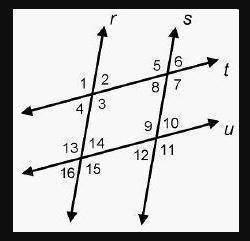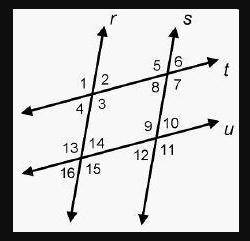 2
2 The correct option is C
C) Lines r and s and lines t and u must be parallel
Step-by-step explanation:
I've attached the figure for this questions below. Consult it for better understanding of the solution.
We have been given 2 conditions that:
Angle 8 is congruent to angle 10Angle 1 is congruent to angle 7When both the pair of lines that are r,s and t,u are parallel, then the angles <8 and <10 as well as <1 and <7 become opposite angle, which are always equal. Even if one pair of lines is not parallel, these conditions won;t hold true.

 2
2 The correct option is C
C) Lines r and s and lines t and u must be parallel
Step-by-step explanation:
I've attached the figure for this questions below. Consult it for better understanding of the solution.
We have been given 2 conditions that:
Angle 8 is congruent to angle 10Angle 1 is congruent to angle 7When both the pair of lines that are r,s and t,u are parallel, then the angles <8 and <10 as well as <1 and <7 become opposite angle, which are always equal. Even if one pair of lines is not parallel, these conditions won;t hold true.

 19
19 C.Lines r and s and lines t and u must be parallel.
Step-by-step explanation:
Line r s and t must be parallel and c is closest to that lol
 26
26 Third option: Lines "r" and "s" and lines "t" and "u" must be parallel.
Step-by-step explanation:
The missing figure is attached.
You need to remember that:
1- A Transversal is defined as a line that intersects two or more lines.
2- When a transversal cut two parallel lines, several angles are formed, which are grouped in pairs. Some of them are:
a. Vertical angles: are those pairs of angles that share the same vertex and are opposite to each other. These angles are congruent.
b. Corresponding angles: are those pairs of non-adjacent angles located on the same side of the transversal and outside the parallel lines. They are congruent.
In this case, you can identify in the figure that:
 and
and  are Corresponding angles.
are Corresponding angles.
 and
and  are Vertical angles.
are Vertical angles.
Therefore, based on the explained before, you can conclude that lines "r" and "s" and lines "t" and "u", must be parallel.

 6
6 C
Step-by-step explanation:
 17
17 <5=<16
Step-by-step explanation:
Define - An angle is said to be another angles exterior angle if
1) It on either side of transversal
2) Both the angles r exterior angle
Here <16 is the one and only exterior angle of <5 as it satisfies the rules for the same.
Therefore
<16 is the exterior angle of <5
there is only 1 exterior angle
Sry dudebut the ans of above guy is wrong
Hope this helps
PLS PLS PLS mark my ans as brainliest :)
 13
13 5 and 13, got in right in edge 2020
Step-by-step explanation:
 4
4 i think is angle 7 n angle 15
Step-by-step explanation:
 24
24 5 to13
Step-by-step explanation:
hope it help
 31
31 7
Step-by-step explanation: count the alternate exterior angles from 5

It will provide an instant answer!
